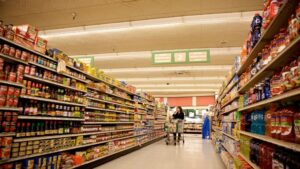
The National Commission on Securities and Stock Market (NSCM) banned trading in shares of 39 joint-stock companies of public interest, which are located in the controlled territories and have not held annual general meetings of shareholders on the results of 2021 and 2022.
“To prohibit from 00 h. 00 min. 26.09.2023g. trading in shares of joint-stock companies listed in the annex to this decision, namely: the execution by investment firms of transactions with shares of these joint-stock companies, related to the transfer of rights to securities and rights on securities,” – stated in the decision of the NCSSM № 1064 of September 25.
The JSCs included, in particular, “ArcelorMittal Kryvyi Rih” (AMKR), “Kryvyi Rih Iron Ore Combine” (KZhRK), “Kryvbasvzvzryprom”, “Pokrovsky GOK”, “Kremenchug Steel Works”, “Hemoplast, Dniprovsky Iron and Steel Works, Sumykhimprom, Nasosenergomash, Dniproazot, Azot and Rivneazot, Sumy Machine-Building NPO, Dniprotyazhmash, and Odessa Brandy Factory.
They also include Lviv Iskra Electric Lamp Plant, Borschagovsky Chemical and Pharmaceutical Plant (BCPP), Inter TV Channel, Novokramatorsk Machine-Building Plant (NKMZ), and Concern Khlebprom, “Concern Galnaftogaz, Bilotserkivska TPP, Naftogazvydobuvannya, Elba, Prosto-Strakhovanie, IC Vona, IC Omega, Eximnaftoprodukt, Odessnaftoprodukt, and Tatarbunarsk ATP No. 15143.
The list also includes Volynoblenergo and Ternopoloblenergo, as well as seven regional gas companies: Poltava, Vinnytsia, Kirovograd, Rivne, Volyn and Chernivtsygaz.
According to the regulator, the JSCs are in a situation when further circulation of their securities will violate the rights of investors.
National depository of Ukraine, self-regulatory organizations UAIB and PARD, as well as trade organizers are instructed to inform the Commission about the implementation of this decision within three days.

The general conference of the International Atomic Energy Agency (IAEA) on September 25 supported the appointment of Rafael Grossi as the agency’s director general for the next four years, namely from the beginning of December 2023.
According to the board’s decision at the 67th session of the general conference in Vienna, the conference particularly recognized Grossi’s efforts to ensure nuclear safety in Ukraine.
“I am honored to have been appointed by unanimous decision of the board to serve another term in office, and I am very grateful for the trust that member countries continue to place in me as chairman of this truly remarkable organization,” Grossi said.
He said, “This comes at a time when we face many serious challenges, and I am fully committed to continuing to do everything in my power to fulfill the IAEA’s important mission in support of global peace and development.”

Industrial production in Ukraine in the first half of 2023 decreased by 2.9%, while last year during this period the decline amounted to 31.9%, the State Statistics Service (Gosstat) has reported.
The agency specified that since March this year has been recorded growth in industrial production: after a jump of 51.2% in March, the recovery slowed to 18.2% in April, 17.9% in May and 13.7% in June.
At the same time, a 40% and 34.4% drop to pre-war January and February 2022, respectively, caused a generally negative result for the half-year.
State Statistics Service specifies that the data are given without taking into account the temporarily occupied territory of Crimea and Sevastopol, as well as part of the temporarily occupied territories in Donetsk and Luhansk regions.
By sector, the statistical office recorded the largest decline – 11.4% – in the supply of electricity, gas and steam in January-June this year, while in the extractive industry it amounted to 9.2%.
Metal ore mining fell the most – by 28.7%, while oil and gas – by only 2.7%, and in coal mining even recorded a slight increase of 0.8%.
In general, the production in the processing industry increased by 3.1% in the first half of the year.
This indicator was provided by the production of motor vehicles – 29.9%, machine building – 12.9%, food industry — 12.1%, production of furniture, repair and installation of machinery – 11.6%, production of rubber and plastic products – 6.5% and woodworking industry – 4%.
The biggest decline in the processing industry was shown by the production of coke and refined petroleum products – 51.4% and metallurgy – 20.9%.
In nominal terms, Ukraine in January-June 2023 realized industrial products (goods, services) worth 1549.66 billion UAH, which is 6.5% more than in January-June 2022 (1455.125 billion UAH), including outside the country – in the amount of 282.363 billion UAH.
According to its data, in June-2023 compared to June-2022, the turnover of realized mining and processing industry increased by 35%.
In the total sales of industrial products for the first six months of 2023, the largest specific weight came from the processing industry (56.2%), supply of electricity, gas, steam and conditioned air (31.3%), mining and quarrying (11.4%), and another 1.1% was water supply, sewerage and waste.
As reported, industrial production in Ukraine in 2022 fell by 36.9%, while in 2021 there was an increase of 1.9%.
Earlier, the research project Experts Club and Maxim Urakin released an analytical video about the economy of Ukraine and the world – the experts club and Maxim Urakin.
You can subscribe to the Experts Club YouTube channel at the link – https://www.youtube.com/@ExpertsClub

Ukraine’s retail turnover in January-June 2023 in comparative prices increased by 7.3% against the same period of 2022, the State Statistics Service (Gosstat) said.
According to the statistical Department, in June this year recorded an increase in retail turnover to June last year by 23.3%, which is slightly less than the indicator in May, when it was 24.3%.
Gosstat specifies that the turnover of retail trade enterprises (legal entities) in the first half of 2023 increased in comparative prices in relation to the first half of 2022 by 4.9%.
Including in June 2023, the growth amounted to 19.1% compared to 20.7% in May.
According to the State Statistics Committee, in nominal terms, the turnover of retail trade in Ukraine in January-June 2023 amounted to UAH 820.9 billion, and retail trade enterprises – UAH 553.6 billion.
Gosstat reminds that the data are given without taking into account the territories temporarily occupied by Russia and part of the territories where hostilities are (were) conducted
As reported, in 2022, retail turnover in Ukraine fell by 21.4%.
In order to increase investment in the development of deposits in Ukraine, it is necessary to remove the classification for official use (DSP) from geological data on critical minerals, according to participants of a special industry conference of the European Business Association (EBA) Mining Day (Mining Day), held in Kiev on Friday.
Denis Alyoshin, Director of Strategic Development at Ukrlicitydobycha, noted that access to information can be a very simple and effective incentive for investment. And now it is possible to get information other than that which has the CPD grip.
“But why now we still have information with the CPD grip? What exactly do we not want to show? When I communicate with international investors, on my project I cannot show the critical information that is needed to evaluate my project. For two or three years we have been sending letters to the Prime Minister or relevant ministries, etc. Everyone supports it, no one understands why we need a CPD,” questions Aleshin.
In his opinion, this is a very simple and very effective step, which will immediately open the door, at least for many investment intentions, “even if not investments, but intentions”. Currently, this is a very painful issue for the industry, the manager emphasized.
Referring to the activities of Ukrlitia, he reported on the implementation of the project for the development of Polokhovskoye lithium deposit (Kirovograd region), the resource base of which is 75 million tons of lithium-bearing ore. The company intends to produce concentrate from it and then lithium hydroxide/carbonate.
“The strategy is to work with Europe, as there is not enough lithium there. Lithium is used in the production of lithium batteries. The plans are to recycle, build a plant. We plan to prepare a study according to EBRD standards to attract financing,” the strategic development director said, adding that one of the biggest problems at the moment is qualified personnel.
In turn, deputy director for investments of the investment company umgi Mykola Shevchenko noted that Ukraine has a number of advantages for attracting investments in subsoil development: “what we have and what we can offer investors”.
“In particular, the vast majority of information in Ukraine is available on various minerals. But there is also CPD on critical minerals. And we support the opening of this information for all investors”, – emphasized Shevchenko, adding that now it is impossible to make a strategic decision on the extraction of certain minerals.
At the same time, the manager named among the advantages of Ukraine – availability of land: in Ukraine there is a mechanism of compulsory purchase of land for system needs, while in a number of countries there is no such thing.
“There is transparency of auctions. There is availability of geological information and detailed exploration of territories, but more openness is needed. Among the economic factors, in particular, the low cost of land ($3 thousand, and for example in Poland – $40 thousand) and the low cost of labor ($600),” – stated the deputy director.
In his opinion, to attract investors it is necessary to guarantee military risks, guaranteed withdrawal of dividends, fiscal incentives: tax vacations, preferential long-term lending, decentralization of taxes, so that part of the tax remained locally. Also speeding up and simplifying the change of land designation, greater openness of all geological information.
“We have invested in most of the projects in Ukraine – in mining, and less in processing, as there are certain chemical processes required, there are difficulties in obtaining permits from environmental authorities,” explained the manager.
Andriy Gorokhov, CEO of umgi, added that there is currently no operating critical materials player in Ukraine that is successful: this means that we are not doing something enough as a society.
“Companies have now taken considerable risks and are investing in critical industry projects. They are doing it themselves thanks to equity capital. With no help from the government. They are doing well and are heroes because they are taking big risks. No strategy from the government, no support. It takes a lot of effort, and it is very difficult to cope with the problems alone,” the top manager emphasized, noting that projects in this area are estimated from $300 million to several billion dollars “to build both production and process.”
Therefore, it is difficult for investors to make decisions taking into account the current situation and low returns on funds invested in the projects.

Ukrainian developers are adapting social infrastructure facilities in their residential projects to the increased requirements of inclusiveness and energy security, responding to the challenges of martial law, companies reported in a survey conducted by Interfax-Ukraine.
According to Alexander Nasikovsky, co-founder and managing partner of DIM Group, today, security issues in social infrastructure facilities, as well as in residential buildings, require an integrated approach.
“In our projects we apply a three-level security system, which includes, among other things, energy security. The projects provide the possibility of using alternative energy sources if necessary, strengthened means of automation of engineering communications. In the buildings we install double-glazed windows with new generation glass, which allows sunlight to penetrate into the room, but does not allow solar heat to pass through, we use heat-resistant mineral wool for insulation”, – he noted.
In the portfolio of DIM Group of Companies there are schools and kindergartens at different stages of realization. Thus, in Lucky Land Residential Complex the construction of six kindergartens is planned, and also the project of school is being realized, the operator of which will be KMDSH. In Park Lake City the company is implementing an elementary school, a community center with a restaurant and a kindergarten for 180 children.
Autonomy of life became one of the important factors in development during the martial law, says Alexey Shmatok, the project manager of Greenville Park. According to him, the “city within a city” principle became even more relevant given the air alerts and curfews.
“Constant air alerts, curfews, missile threats – the reasons why a person wants to have all the necessary infrastructure very close by, within a 10-15 minute walk. Parking, shelter, store, pharmacy, playground, school, cafe – all on the territory of the LCD to quickly get everywhere in case of danger,” he explained in a comment to the agency.
Along with autonomy, the inclusiveness of space plays an important role today. According to Schmatok, underground parking lots in Greenville projects are designed with inclusivity in mind, as these spaces will also be used as shelters.
“Total inclusivity is our new reality. Considering the large number of people who are injured and disabled as a result of war, every responsible developer must necessarily design and make in their facilities, whether social or commercial, everything necessary for all people to fully and freely use them, live comfortably and do not experience any limitations,” Dmitry Novikov, marketing director of City One Development, told Interfax-Ukraine.
On the territory of the residential complex “Novopecherskie Lipki” it is planned to build another school and kindergarten, which will also be realized taking into account the norms of inclusiveness and energy efficiency, Novikov said.
According to him, today the most energy-independent object of the developer’s social infrastructure is a kindergarten Leapkids.
“Even during construction, innovative technologies and energy-efficient solutions were applied, which allow the kindergarten to be independent of the city networks: solar collectors for heating and hot water supply, water treatment and purification system, special wells receive geothermal heat energy, which is processed into physically tangible heat. There is a ventilation system with recuperation,” he pointed out.
In its turn, KAN Development continues the construction of A+ school on the territory of “Faina Town” Residential Complex and realizes a recreation area with a swimming pool in “Republic” Residential Complex. KAN adjusts the projects of the complexes, adding shelters for the needs of children and teachers, as well as regulates the heating of houses with its own thermal boilers. We welcome people with different physical abilities on our doorstep: entrances to the buildings are designed without stairs, the ramp slope for access to courtyards is 10%, and in the entrance groups of housing and commercial premises – 2-3%,” the company reported.
In the portfolio of “Intergal-Bud” in the metropolitan region – four built educational institutions, the construction of preschool educational institution in the Residential Complex “Syretskye Gardens” continues, said the commercial director of the company Anna Laevskaya.
“Schools in our Residential Complexes meet the current requirements for energy efficiency and inclusiveness. Moreover, we take into account our previous experience and feedback from education operators who rent these buildings to improve the projects in the future,” the expert emphasized.